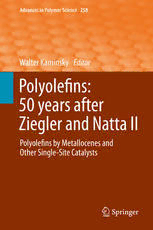
Polyolefins: 50 years after Ziegler and Natta II: Polyolefins by Metallocenes and Other Single-Site Catalysts PDF
Preview Polyolefins: 50 years after Ziegler and Natta II: Polyolefins by Metallocenes and Other Single-Site Catalysts
Advances in Polymer Science 258 Walter Kaminsky Editor Polyolefins: 50 years after Ziegler and Natta II Polyolefins by Metallocenes and Other Single-Site Catalysts 258 Advances in Polymer Science EditorialBoard: A.Abe,Tokyo,Japan A.-C.Albertsson,Stockholm,Sweden G.W.Coates,Ithaca,NY,USA J.Genzer,Raleigh,NC,USA S.Kobayashi,Kyoto,Japan K.-S.Lee,Daejeon,SouthKorea L.Leibler,Paris,France T.E.Long,Blacksburg,VA,USA M.Mo¨ller,Aachen,Germany O.Okay,Istanbul,Turkey B.Z.Tang,HongKong,China E.M.Terentjev,Cambridge,UK M.J.Vicent,Valencia,Spain B.Voit,Dresden,Germany U.Wiesner,Ithaca,NY,USA X.Zhang,Beijing,China Forfurthervolumes: http://www.springer.com/series/12 Aims and Scope TheseriesAdvancesinPolymerSciencepresentscriticalreviewsofthepresentand futuretrendsinpolymerandbiopolymerscience.Itcoversallareasofresearchin polymerandbiopolymerscienceincludingchemistry,physicalchemistry,physics, materialscience. The thematic volumes are addressed to scientists, whether at universities or in industry,whowishtokeepabreastoftheimportantadvancesinthecoveredtopics. AdvancesinPolymerScienceenjoysalongstandingtraditionandgoodreputa- tioninitscommunity.Eachvolumeisdedicatedtoacurrenttopic,andeachreview critically surveys one aspect of that topic, to place it within the context of the volume.Thevolumestypicallysummarizethesignificantdevelopmentsofthelast 5to10yearsanddiscussthemcritically,presentingselectedexamples,explaining and illustrating the important principles, and bringing together many important referencesofprimaryliterature.Onthatbasis,futureresearchdirectionsinthearea canbediscussed.AdvancesinPolymerSciencevolumesthusareimportantrefer- ences for every polymer scientist, as well as for other scientists interested in polymerscience-asanintroductiontoaneighboringfield,orasacompilationof detailedinformationforthespecialist. Review articles for the individual volumes are invited by the volume editors. Singlecontributionscanbespeciallycommissioned. Readership:Polymerscientists,orscientistsinrelatedfieldsinterestedinpoly- merandbiopolymerscience,atuniversitiesorinindustry,graduatestudents. Specialoffer: For all clients with a standing order we offer the electronic form of Advances in PolymerSciencefreeofcharge. Walter Kaminsky Editor Polyolefins: 50 years after Ziegler and Natta II Polyolefins by Metallocenes and Other Single-Site Catalysts With contributions by (cid:1) (cid:1) (cid:1) (cid:1) M. Anselm L. Boggioni H.H. Brintzinger L. Cui (cid:1) (cid:1) (cid:1) (cid:1) D. Fischer K. Hakala T. Halbach W. Kaminsky E.Kokko(cid:1)A.Kurek(cid:1)P.Lehmus(cid:1)S.Lipponen(cid:1)B.Lo¨fgren(cid:1) (cid:1) (cid:1) (cid:1) G.A. Luinstra R.S.A. Meyer T.C. Mike Chung R. Mu¨lhaupt (cid:1) A. Pakkanen ne´e Malmberg (cid:1) A. Razavi (cid:1) J. Seppa¨la¨ (cid:1) T. Shiono (cid:1) H. Sinn (cid:1) W.-H. Sun (cid:1) M. Stu¨rzel (cid:1) (cid:1) (cid:1) N.H. Tarte I. Tritto S. Woo Editor WalterKaminsky Dept.ofChemistry Inst.forTechn.andMacromol.Chemistry UniversityofHamburg Hamburg Germany ISSN0065-3195 ISSN1436-5030(electronic) ISBN978-3-642-40804-5 ISBN978-3-642-40805-2(eBook) DOI10.1007/978-3-642-40805-2 SpringerHeidelbergNewYorkDordrechtLondon LibraryofCongressControlNumber:2013955573 #Springer-VerlagBerlinHeidelberg2013 Thisworkissubjecttocopyright.AllrightsarereservedbythePublisher,whetherthewholeorpartof the material is concerned, specifically the rights of translation, reprinting, reuse of illustrations, recitation,broadcasting,reproductiononmicrofilmsorinanyotherphysicalway,andtransmissionor informationstorageandretrieval,electronicadaptation,computersoftware,orbysimilarordissimilar methodologynowknownorhereafterdeveloped.Exemptedfromthislegalreservationarebriefexcerpts inconnectionwithreviewsorscholarlyanalysisormaterialsuppliedspecificallyforthepurposeofbeing enteredandexecutedonacomputersystem,forexclusiveusebythepurchaserofthework.Duplication ofthispublicationorpartsthereofispermittedonlyundertheprovisionsoftheCopyrightLawofthe Publisher’s location, in its current version, and permission for use must always be obtained from Springer.PermissionsforusemaybeobtainedthroughRightsLinkattheCopyrightClearanceCenter. ViolationsareliabletoprosecutionundertherespectiveCopyrightLaw. The use of general descriptive names, registered names, trademarks, service marks, etc. in this publicationdoesnotimply,evenintheabsenceofaspecificstatement,thatsuchnamesareexempt fromtherelevantprotectivelawsandregulationsandthereforefreeforgeneraluse. While the advice and information in this book are believed to be true and accurate at the date of publication,neithertheauthorsnortheeditorsnorthepublishercanacceptanylegalresponsibilityfor anyerrorsoromissionsthatmaybemade.Thepublishermakesnowarranty,expressorimplied,with respecttothematerialcontainedherein. Printedonacid-freepaper SpringerispartofSpringerScience+BusinessMedia(www.springer.com) Preface Fifty years after the NobelPrize was awarded toKarl Ziegler andGiulioNattain 1963,thepolymerizationofolefinsbymetallorganiccatalystshasgrowntooneof themostfascinatingareasinacademicandindustrialpolymerscienceandnowhas thelargestuseinpolymerproduction.Zieglerhaddiscovered10yearsearlierthata mixtureoftransitionmetalcompounds,especiallytitaniumchloridesandaluminum alkyls, was able to polymerize ethene by an insertion reaction. This spectacular milestone was expanded a year later when Natta prepared and characterized isotactic polypropylene and introduced stereospecific polymerization. In contrast to the high-pressure ethene polymerization invented in 1935 by ICI (Imperial Chemical Industries, Great Britain), the catalyzed olefin polymerization requires onlylowpressureandlowtemperature. Today, more than 130 million tons of polyolefins are produced worldwide per year, the major part with the help of Ziegler–Natta catalysts. Polyolefins have changed the world! They are not only the polymers with the highest production volume, but they also show an unbroken production increase. Containing only carbonandhydrogenatoms,polyolefinsare sustainablematerials, lightinweight, andofferawidevarietyofproperties.Theproductionrequiresonlyeasilyavailable andnontoxicmonomersandproceedswithalmostnolossesorsidereactions.After theirendofuse,polyolefinscaneasilyberecycledthroughmechanicalprocedures tosimplearticles,bypyrolysistogasandoil,orbyincinerationtoenergy. In recent decades, new generations of catalysts with higher activities and stereospecificitiesandmodernproductionprocesseshavebeeninventedtoproduce a great variety of polyolefins ranging from high density polyethylene (HDPE) to linearlowdensitypolyethylene(LLDPE),highmeltingpolypropylene,highmod- uluspolyolefinfibers,ethene–propenerubber(EPR),ethene–propene–dienemono- merrubber(EPDM).Thechromium-basedPhillipscatalystsopenedthefieldofgas phase polymerization for HDPE. New supported Ziegler–Natta catalysts make it possibletoincreasetheactivity,tocontrolthemorphology,andforpolypropylene toincreasetheisotacticitybyaddingdifferentkindsofdonors. Agreatdevelopmentinthisresearchfieldwasthediscoveryofmetalloceneand othertransitionmetalcomplexesactivatedbymethylaluminoxane.Thesecatalysts v vi Preface are up to 10 times more active than Ziegler–Natta catalysts, are soluble in hydro- carbons,showonlyonetypeofactivesite(singlesitecatalysts),andcaneasilybe modifiedintheirchemicalstructure.Thesepropertiesmakeitpossibletopredictthe properties of the resulting polyolefins very accurately from the knowledge of the structure of the catalyst, and thus to control molecular weight and distribution, comonomer content, and tacticity by careful selection of the appropriate reactor conditions.Thesinglesitecharacterofmetallocene-basedcatalystsleadstoabetter understandingofthemechanismofolefinpolymerizationandtotheintroductionof otherbulkycocatalysts. Thedifferentchaptersinthisbookdealwiththedevelopmentofolefinpolymer- ization 50 years after the pioneering work of Ziegler and Natta. Academic and industrial developments of ethene and propene polymerizations are presented, including short biographies of Ziegler and Natta, research on Phillips catalysts, kinetic and active site measurements, and polyolefin characterization. Review chaptersalsodescribethelatestresultsofolefinhomo-,living-,andcopolymeriza- tions by metallocene and other single site catalysts, such as the synthesis of ansa metallocenes, supported iron catalysts, syndiotactic polypropylene, long chain branchedpolyolefins,andcyclicandfunctionalcopolymers.Remarkableprogress has been achieved in the synthesis of polyolefin nanocomposites by an in-situ polymerization process using clay, layered silicates, carbon fibers, and carbon nanotubesasfillers. I thank all the authors very much for giving their time to write these exciting chapters. Hamburg,Germany WalterKaminsky Contents Methylaluminoxane:KeyComponentforNewPolymerization Catalysts ........................................................................ 1 WalterKaminskyandHansjo¨rgSinn Developmentofansa-MetalloceneCatalystsforIsotacticOlefin Polymerization ................................................................. 29 HansH.BrintzingerandDavidFischer SyndiotacticPolypropylene:Discovery,Development, andIndustrializationviaBridgedMetalloceneCatalysts .................. 43 AbbasRazavi PolyolefinswithCyclicComonomers ....................................... 117 LauraBoggioniandIncoronataTritto Trialkylaluminum-FreeModifiedMethylaluminoxane asaCocatalystforLivingPolymerizationofOlefins ...................... 143 TakeshiShiono NovelPolyethylenesviaLateTransitionMetalComplex Pre-catalysts .................................................................. 163 Wen-HuaSun FunctionalPolyolefinsThroughPolymerizationsbyUsingBis(indenyl) ZirconiumCatalysts ......................................................... 179 JukkaSeppa¨la¨,EsaKokko,PetriLehmus,AnneliPakkanenne´eMalmberg, KimmoHakala,SamiLipponen,andBarbroLo¨fgren FunctionalPolyolefins:SynthesisandEnergyStorageApplications ..... 233 T.C.MikeChung vii viii Contents PolyolefinNanocompositesandHybridCatalysts ......................... 279 MarkusStu¨rzel,AlexanderKurek,MelanieAnselm,TobiasHalbach, andRolfMu¨lhaupt Polyolefin/LayeredSilicateNanocompositesPrepared byInSituPolymerization ................................................... 311 NareshH.Tarte,LiqiangCui,andSeongIhlWoo IronCatalystinthePreparationofPolyolefinComposites ............... 341 RobertS.A.MeyerandGerritA.Luinstra Index .......................................................................... 363 AdvPolymSci(2013)258:1–28 DOI:10.1007/12_2013_226 #Springer-VerlagBerlinHeidelberg2013 Publishedonline:12June2013 Methylaluminoxane: Key Component for New Polymerization Catalysts WalterKaminskyandHansjo¨rgSinn Abstract Theuseofmethylaluminoxane(MAO)ascocatalystforthepolymerization ofolefinsandsomeothervinylcompoundshaswidelyincreasedthepossibilitiesfor morepreciselycontrollingthepolymercomposition,polymerstructure,tacticity,and specialproperties.Highlyactivecatalystsare obtainedbydifferenttransitionmetal complexessuchasmetallocenes,half-sandwichcomplexes,andbisiminocomplexes combinedwithMAO.Thesecatalystsallowthesynthesisofpolyolefinswithdifferent tacticities and stereoregularities, new cycloolefins and other copolymers, and poly- olefin composite materials of a purity that cannot be obtained by Ziegler–Natta catalysts. The single-site character of metallocene/MAO or other transition metal/ MAO catalysts leads to a better understanding of the mechanism of olefin polymerization. Keywords Metallocene catalysts (cid:1) Methylaluminoxane (cid:1) Olefin polymerization (cid:1) Single-sitecatalysts Contents 1 Introduction................................................................................... 2 2 FormationandStructureofMAO............................................................ 4 3 NewPolyolefins.............................................................................. 9 W.Kaminsky(*) InstituteforTechnicalandMacromolecularChemistry,UniversityofHamburg, Bundesstraase45,20146Hamburg,Germany e-mail:[email protected] H.Sinn GuestattheTechnicalUniversityClausthal, InstituteforTechnicalandMacromolecularChemistry,UniversityofHamburg, Bundesstraase45,20146Hamburg,Germany e-mail:[email protected]
